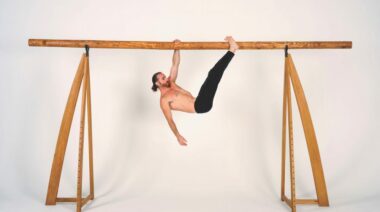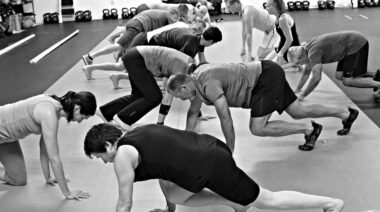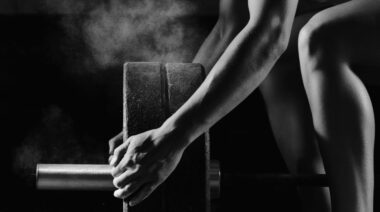I’m really bad at balancing on narrow, round things. Especially if they are high up. I know the technical points I’m supposed to observe, but I still suck at it. I suck at it because I’ve been woefully negligent in practice, so over the summer I made it my “lazy mission” to improve my balancing to a respectable level. I tried just paying attention to the technical elements and trying to do those well. It helped some, but that strategy wasn’t enough, so I borrowed some tools for improvement I have used a lot in Brazilian jiu-jitsu (BJJ).
Low-Key Strategies for Skill
Using these tools, I was able to take my first try balance on a waist-high, round bar hand rail from an awkward :20 seconds to a fairly comfortable 3:54 minutes.
Set a Simple Goal
There are six and a half billion goal setting books, blog posts, and videos out there, so I’ll spare you another one. I kept my goal simple and rough. I just wanted to be able to stay on the damn bar without looking stupid for three minutes cold, first try. I wanted to be able to do this with no warm up or practice, so I could just randomly hop onto something and balance for enough time to accomplish a task if I needed to. Since this was a “lazy mission,” I wanted to keep this a fun goal, but still something I could progress with. Success minus the stress. I picked Friday lunch break as my time to practice, because I could devote a good 20 minutes to getting better and there was a perfect practice bar right next to the BJJ school where I work.
Videotape Yourself
I used my phone to record my attempts; unfortunately, I erased most of my footage in a complicated accident. But you aren’t missing much. Just me flailing around for a few weeks, then starting to walk around more comfortably on a metal bar.
There were a few benefits to taping myself. First, I was able to immediately see what I was doing and how it differed from what I thought I was doing. Those two things can be surprisingly different. By comparing what I was actually doing with what I thought I was doing, I was able to instantly make improvements. I got a good sense of what happened when I would lose my balance, what the causes were, how my body reacted to the loss of balance, and how I could design and practice drills to improve on those points.
Also, comparing my videos to videos of more skillful people practicing and performing gave me valuable insight into what I wanted to look like and model myself after on the bar. I was able to make improvements by trying to match certain points of my technique with theirs.
Tools that encourage consistent, positive practice will help you achieve your goal. [Photo credit: Adam Jones|CC BY SA 2.0]
Take Notes
After each try, I wrote down what seemed to work to keep me up there longer. Taking notes helped me observe the technical points I learned in the Movnat courses. I also wrote down what didn’t work very well, and what factors were causing problems. Things like: different types of footwear as opposed to bare feet, different bar/branch heights or widths and if bar was slippery from skateboarders putting wax on it. I came up with a good mental and physical formula that worked well for me.
I found I always did better when I breathed slowly and relaxed my whole body as much as possible. I would lightly press downwards into the bar to feel more connected. I also would try to keep my focus 80% on the task, while keeping some awareness of my surroundings, lest someone try to run off with my bike while I was slinking around the bar. I also found that talking to myself helped a lot. I would murmur under my breath stuff like “Dude, this is so easy. You could balance on here forever.” I don’t know why that helped, but it really did make it easier for me to stay on. I would test out ideas and constantly trim out things which were useless or counterproductive to my improvement.
I made a point to always begin my next session by focusing on the most helpful points I observed from the prior session in my notes.
Passive Competition and Regular Practice
I mentioned earlier that I would seek out experienced people on video to compare myself to. Part of this was modeling and trying to pick up technical points to implement. The other part was competitive. I use a light-hearted and friendly competitiveness to improve my skills in other areas, and it helped here. I would study video of people who were actually good at balancing and challenge myself to get better at it than them. I seldom accomplished that goal, but the friendly competitiveness was enough to motivate me to do an extra five minutes when I wanted to be done, or to go out and practice when I didn’t feel like practicing. I came away with more practice and better skill than I would have, were I only focused on myself.
You run faster trying to catch someone than you do running alone.
A funny side note about this: I notice that I improved even more if I tried to compete with people who I find obnoxious. This is definitely something I picked up from BJJ. People there are mostly awesome, but there are a handful unlikable personalities around who would be hard to swallow a loss from. Some MMA fighters talk about this too, using dislike of an opponent to fuel their training. But this tactic is just a lighthearted thing, not too serious. It’s more, “Haha, that dude gets on my nerves, I want to be better at this than him,” than a super negative or hateful thing. It works the same way if you have a training buddy that talks a little trash to you. You will work harder just to shut him up. It’s a mental trick I use when I’m struggling to find motivation.
Use Whatever Tools Work
Ultimately, these tools boil down to finding ways to chart progress and find motivation to inspire progress and consistency of practice. By taping myself and taking notes of best practices and ineffective practices, I can get a sense of what really works for me. These tools help me get a clear picture of how it works, and avoid the mismatch between what I think is happening and what really happens. By using a lighthearted form of competitiveness, I give myself that kick in the butt I need to go out and practice or keep going for another five minutes when I am really tempted to go back home and watch cat videos on Facebook.
More ways to advance your fitness:






